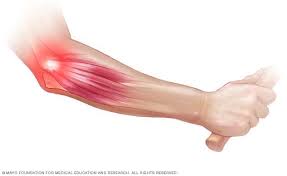What is tennis elbow?
Tennis elbow is a very painful condition that weakens the tendons that join your forearm muscles to your bones. The condition usually causes an inflammatory response which worsens with repetitive arm and elbow motions.

Any activity that involves twisting or gripping of the forearm can cause this strain on the elbow. The medical name for this is lateral epicondylitis. Tennis elbow is not exclusive to tennis players – you can get it for so many different reasons. It is a common injury that can take time to heal.
What are the early signs and symptoms of tennis elbow?
Everyone’s symptoms differ. Some experience very mild discomfort while others have such bad pain they cannot move their arm or even sleep at night.
The most common symptom is an ache on the outside of your elbow which can radiate to the forearm. After time this ache can turn into a constant pain and can be agonising to touch.
As well as pain and tenderness to your elbow, you may find that carrying out daily activities such as brushing your hair, washing, and holding a mug can be difficult.
Some common symptoms include:
- Tenderness on the outside of your elbow
- Stiffness with persistent aching
- Very sore forearm muscles
- Elbow pain worsens when trying to grab or hold an object
- Pain when extending your arm
- Pain when shaking hands with someone
- Holding a cup
- Pain when using the computer
What is the treatment for tennis elbow?
For many, tennis elbow will get better with time on its own, although this can seem like an eternity when you’re suffering. Taking over the counter anti-inflammatory medication can help. In addition to this, your doctor may recommend physiotherapy.
If a course of physiotherapy has made no significant improvement to your pain levels and your tennis elbow is severe, you may need a steroid injection or surgery.
There are some measures you can take at home to help you with pain relief. These include:
- Resting your elbow for a few days and avoiding any activities that give you pain
- Massaging the affected area with topical anti-inflammatory creams or gels
- Taking regular breaks at work or at home on any tasks that may cause you discomfort
- Avoid lifting any heavy objects
- Hot and cold compress on the affected area
- Wearing a support brace or bandage on your arm to give you more support during the day
- A course of shockwave therapy treatment
- A course of acupuncture treatment
How long does it take to recover from tennis elbow?
In most cases tennis elbow will respond to conservative treatments at home, but it can take from weeks to months to fully heal from this injury. It is important not to rush your recovery. If you start pushing yourself too quickly you can make the damage to your elbow worse. You can return to normal activities when:
- Gripping objects or bearing any weight on your arm/elbow is no longer painful
- Your elbow has regained the strength that it lost
- Your elbow has no swelling
- You can flex your elbow or move your wrist without the pain you have been experiencing
How should you sleep with tennis elbow?
Since being diagnosed with tennis elbow, you may find that sleeping has become very uncomfortable. If wearing an arm brace helps you to get a good night’s sleep, then this is advised. Alternatively, use pillows to prop your arm up as straight as it can be.
How physiotherapy can help your tennis elbow
We will do whatever we can to get you on the fastest route to recovery. Some of the treatment methods we use include:
- Mobilisation
- Strengthening exercises
- Myofascial trigger point release
- Cross-friction massage
- Stretching and range of movement exercises
- Acupuncture
- Finding the correct sleeping position for you
- Functional exercises
- Kinesio-taping
